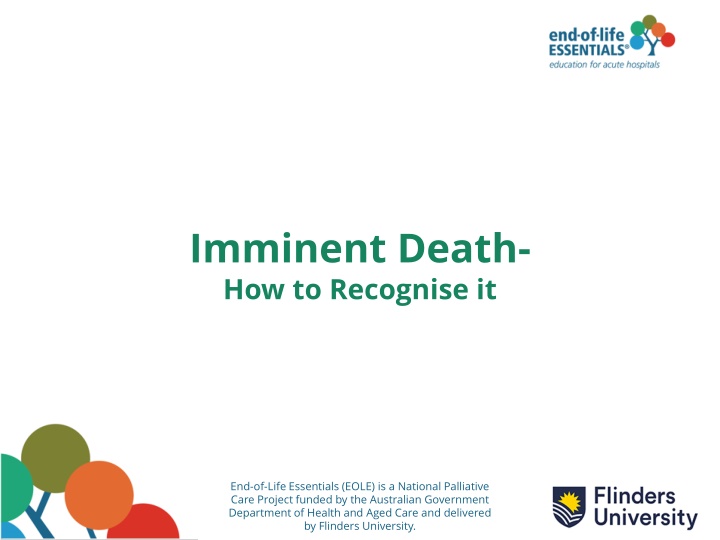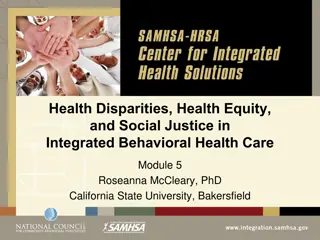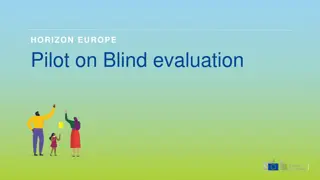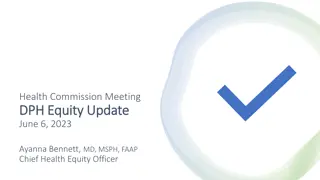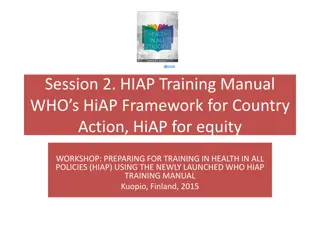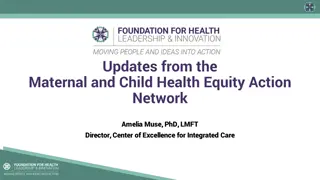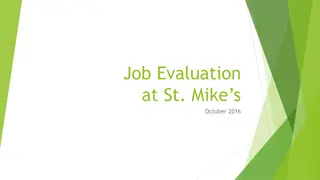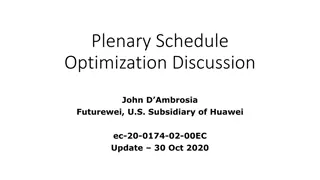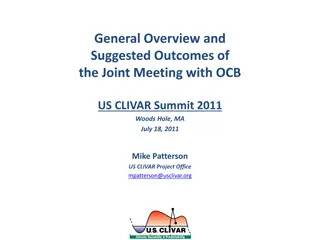Joint Action Health Equity Europe Plenary Meeting Evaluation
Evaluation framework and plan for Monitoring and Evaluation Work Package 3 (WP3) in the Joint Action Health Equity Europe project, focusing on measuring project success, assessing objectives, developing evaluation criteria, and supporting Member States with implementation guidelines.
Download Presentation

Please find below an Image/Link to download the presentation.
The content on the website is provided AS IS for your information and personal use only. It may not be sold, licensed, or shared on other websites without obtaining consent from the author.If you encounter any issues during the download, it is possible that the publisher has removed the file from their server.
You are allowed to download the files provided on this website for personal or commercial use, subject to the condition that they are used lawfully. All files are the property of their respective owners.
The content on the website is provided AS IS for your information and personal use only. It may not be sold, licensed, or shared on other websites without obtaining consent from the author.
E N D
Presentation Transcript
Imminent Death- How to Recognise it End-of-Life Essentials (EOLE) is a National Palliative Care Project funded by the Australian Government Department of Health and Aged Care and delivered by Flinders University.
Aims and objectives After completing this talk, you should be able to: Identify the opportunities for skilled, compassionate clinical care during the final days and hours of life Identify the signs of impending death Recognise reversible causes of decline Recognise the five steps to deprescribing Identify which End-of-Life Essentials module to complete next.
The term imminent death means that a person is experiencing irreversible decline in health and that they are likely to die within hours, days or weeks. 1
Signs of imminent death CLICK THIS LINK To watch the video by Melissa Bruno, Nurse Consultant at Northern Adelaide Local Health Network, and Lecturer (Clinical Teaching Specialist) College of Nursing and Health Sciences, Flinders University, talking through some signs and symptoms of imminent death ( 4 mins, 7 seconds).
Signs of imminent death Sign Profound tiredness and weakness2 What does it look like? Reduced interest in getting out of bed. Needing assistance with all care. Less interest in things happening around them. Decrease in appetite and thirst is a normal progression of the body slowing down. Difficulty in concentration. Confusion with time and place. Inability to communicate. Slow or irregular breathing. Periods of rapid, shallow breathing Cheyne-Stokes breathing is a term used to describe when a patient is having periods of apnoea followed by rapid respirations. Skin becomes pale and cool to touch due to peripheral vascular shutdown- this is when the body s circulation slows down, blood is reserved for helping major internal organ function. Agitation Confusion Delirium Emotional distress Diminished food and fluid intake2 Drowsy or reduced cognition2 Changes to breathing3 Changes to colour of the skin4 Terminal restlessness3
Terminal restlessness Terminal restlessness is the term for a spectrum of unsettled behaviours and symptoms that can happen at the end of a person s life.5 Agitation, confusion, delirium and emotional distress are common symptoms.5
Reversible causes of decline Some conditions may produce similar signs of imminent death but may be treated. Be aware of reversible causes of decline, which may include:6 hypercalcaemia (high level of calcium in the blood) renal (kidney) failure infection side effects of medicines such as strong opioids.
Goals of care and patient wishes Understand the progress of the individual patient s illness, the goals of care, the patient and family s wishes. The benefits and burdens of investigations or potential treatments. Remember, just because a blood test or investigation can be ordered, does not mean it should be ordered. A team and family approach to confirm goals of care should steer care and services at the end of life.7
Symptom control Ensure that medications for common symptoms such as breathlessness, pain, nausea, and constipation are prescribed for PRN use (as needed). There are several common symptoms that may cause distress in dying patients. Ordering medications ahead of time, anticipatory prescribing , is required so that prompt management of these symptoms can occur.8
Medication management Five steps to deprescribing9 Take detailed medication history including indication for each drug. Consider potential for drug induced harm i.e. age of patient, comorbidities, number of medications, types of medications. Consider each individual medication and the potential to provide ongoing benefit. Prioritise medications for deprescribing (usually one at a time), give explanations to the patient. Agree on follow-up arrangements. Carry out follow-up assessment to assess effects of deprescribing. Consider further deprescribing. 1. 2. 3. 4. 5. Deprescribing is not withdrawal of care.
Responding to a patient in your care imminently dying Knowing that someone is dying on an acute ward on your shift can be confronting, especially if your training and practice has focussed mainly on ensuring patients live. Knowing how to respond is the key and this knowledge can help you feel more at ease when you are delivering care. Watch the video below of an example of imminent patient death in an acute hospital. CLICK THIS LINK
Confirming death for the patients family What can you say to the family when they ask you 'Has mum died? Think about how you could respond with compassion
Summary Signs of impending death can be useful to know in terms of providing more information to families and planning your clinical response. Be aware of reversible causes of decline. Anticipatory prescribing can be used to prevent or reduce common distressing symptoms. Deprescribing is not withdrawal of care. Compassionate communication during the final days of life and once the patient has died can make a huge difference to all involved.
What module to complete next? Communication and Decision-Making Recognising Dying Planning EOL Goals of Care
References 1. CareSearch. The dying patient. 2023. 2. Watson M, Campbell R, Vallath N, Ward S, Wells J. Oxford Handbook of Palliative Care: The Essential, Holistic Guide to Palliative Care. Oxford Medical Publicatios. 2019;15(5). 3. Ijaopo EO, Zaw KM, Ijaopo RO, Khawand-Azoulai M. A Review of Clinical Signs and Symptoms of Imminent End-of-Life in Individuals With Advanced Illness. Vol. 9, Gerontology and Geriatric Medicine. 2023. 4. Hui D, dos Santos R, Chisholm G, Bansal S, Silva TB, Kilgore K, et al. Clinical Signs of Impending Death in Cancer Patients. Oncologist [Internet]. 2014 Jun 1;19(6):681 7. Available from: https://doi.org/10.1634/theoncologist.2013-0457 5. White C, McCann MA, Jackson N. First Do No Harm Terminal Restlessness or Drug-Induced Delirium. J Palliat Med [Internet]. 2007 Apr 1;10(2):345 51. Available from: https://doi.org/10.1089/jpm.2006.0112 6. National Clinical Guideline Centre (NICE). Care of Dying Adults in the Last Days of Life. London; 2015 Dec. 7. Montori VM, Ruissen MM, Hargraves IG, Brito JP, Kunneman M. Shared decision-making as a method of care. BMJ Evid Based Med [Internet]. 2023 Aug 1;28(4):213. Available from: http://ebm.bmj.com/content/28/4/213.abstract 8. Cadogan CA, Murphy M, Boland M, Bennett K, McLean S, Hughes C. Prescribing practices, patterns, and potential harms in patients receiving palliative care: A systematic scoping review. Exploratory Research in Clinical and Social Pharmacy [Internet]. 2021;3:100050. Available from: https://www.sciencedirect.com/science/article/pii/S2667276621000500 9. Thompson J. Deprescribing in palliative care. Clinical Medicine, Journal of the Royal College of Physicians of London. 2019;19(4).
